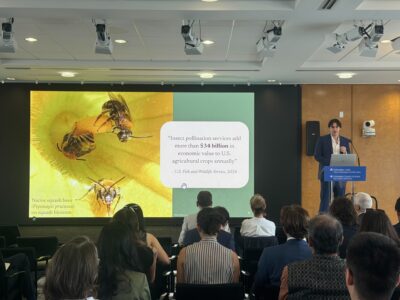
On Monday, June 22, the newest Master of Public Administration in Environmental Science & Policy (MPA-ESP) candidates spent a beautiful, sunny day touring Columbia’s Lamont-Doherty Earth Observatory, just a short bus ride away in Palisades, NY. Led by Environmental Chemistry professor Benjamin Bostick and Climatology professor Jason Smerdon, the students were exposed to many different areas of groundbreaking research that the world-class facility has to offer.
In the morning, several guest lecturers offered insight into life at Lamont and the various types of work they did. Marc Levy, Deputy Director of the Center for International Earth Science Information Network (CIESIN), a component of the Earth Institute, set the tone early on during his discussion of the links between climate-induced stressors and political violence. He cited several examples, including how ongoing droughts in Syria have resulted in massive civilian displacements and ongoing civil and regional strife. The intense policy focus that comes with globalization and the relatively new notion of “environmental security” was a popular topic amongst students.
Later on, a recent ESP graduate, Alyssa Fico (MPA ESP ’15) spoke about her work at CIESIN, combining natural, social, and information sciences to provide people across the world with accessible data related to the impacts of human behavior on the environment. Through aggregating and managing this information, CIESIN hopes to help researchers, policymakers, and the general public better understand the dynamic relationship between humans and their environment. Students were encouraged to see a recent alumnus working at Lamont just days after graduating from the MPA-ESP program at SIPA, and expressed interest in following a similar path.

After lunch, the program was able to tour the facilities themselves, including the award-winning Comer Geochemistry building and the Core Repository, where thousands of core samples from the ocean floor, some 100 million years old, are stored and analyzed to provide clues about the Earth’s natural history and how it has changed over time. In fact, several of the program’s science labs throughout the summer base their data off previous work done at Lamont over the years, a fact that many students enjoyed. “It was really incredible to learn about the history of Lamont and how all the work these people have done has carried over to our program and the global scientific community as a whole,” said Ali Zamani, a member of the class of 2016. Fellow classmate Travis Tran considered himself “fortunate, awed and inspired” to have been able to tour the campus, calling it a reminder how important his time at Columbia is in preparing himself to one day be a better equipped leader in making the world a better place.
****
Students in the MPA in Environmental Science and Policy program enroll in a year-long, 54-credit program offered at Columbia University’s School of International and Public Affairs, in partnership with the Earth Institute.
Since it began in 2002, the MPA in Environmental Science and Policy program has given students the hands-on experience, and the analytical and decision-making tools to implement effective environmental and sustainable management policies. The program’s 741 graduates have advanced to jobs in domestic and international environmental policy, working in government, private and non-profit sectors. Their work involves issues of sustainability, resource use and global change, in fields focused on air, water, climate, energy efficiency, food, agriculture, transportation and waste management. They work as consultants, advisers, project managers, program directors, policy analysts, teachers, researchers and environmental scientists and engineers.
Visit our website for more information: http://mpaenvironment.ei.columbia.edu/



